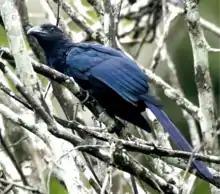Greater ani
The greater ani (Crotophaga major) is a large bird in the cuckoo family. It is a breeding species from Panama and Trinidad through tropical South America to northern Argentina. It is sometimes referred to as the black cuckoo.
| Greater ani | |
|---|---|
.jpg.webp) | |
| Scientific classification | |
| Kingdom: | Animalia |
| Phylum: | Chordata |
| Class: | Aves |
| Order: | Cuculiformes |
| Family: | Cuculidae |
| Genus: | Crotophaga |
| Species: | C. major |
| Binomial name | |
| Crotophaga major (Gmelin, 1788) | |
 | |
This ani is found in mangrove swamps, semi-open woodland near water, and the edges of forests. It is a seasonal migrant in at least some parts of its range. The nest, built communally by several pairs, is a deep cup lined with leaves and placed usually 2–5 m (6.6–16.4 ft) high in a tree. A number of females lay their chalky deep blue eggs in the nest and then share incubation and feeding. These breeding groups may also include non-breeding helpers.[2] Nests have been found containing 3–10 eggs. In a recent longterm study, it was found that around 15% of females lay their eggs in the nest of another nesting group. This conspecific brood parasitism happens primarily when a female has lost her own clutch to predation.[3]

The greater ani is about 48 cm (19 in) long and weighs 170 g (6.0 oz). The adult is mainly blue-glossed black, with a long tail, massive ridged black bill, and a white iris. Immature birds have a dark iris.
This is a very gregarious species, always found in noisy groups. The calls include croaking and turkey-like gobbling kro-koro. The greater ani feeds on large insects and even lizards and frogs.
References
- BirdLife International (2012). "Crotophaga major". IUCN Red List of Threatened Species. 2012. Retrieved 26 November 2013.CS1 maint: ref=harv (link)
- Riehl Christina; Strong Meghan J. (2018-04-11). "Stable social relationships between unrelated females increase individual fitness in a cooperative bird". Proceedings of the Royal Society B: Biological Sciences. 285 (1876): 20180130. doi:10.1098/rspb.2018.0130. PMC 5904317. PMID 29643212.
- Meghan J. Strong; Riehl, Christina (March 2019). "Social parasitism as an alternative reproductive tactic in a cooperatively breeding cuckoo". Nature. 567 (7746): 96–99. doi:10.1038/s41586-019-0981-1. ISSN 1476-4687. PMID 30814729.
External links
| Wikimedia Commons has media related to Crotophaga major. |
| Wikispecies has information related to Crotophaga major. |
- "Crotophaga major". Integrated Taxonomic Information System.
- Ani defined at Merriam Webster Online
- BirdLife species factsheet for Crotophaga major
- "Greater ani media". Internet Bird Collection.
- Greater Ani photo gallery at VIREO (Drexel University)
- Greater Ani species account at Neotropical Birds (Cornell Lab of Ornithology)
- "Crotophaga major". Avibase.

- Interactive range map of Crotophaga major at IUCN Red List maps
- Audio recordings of Greater Ani on Xeno-canto.
